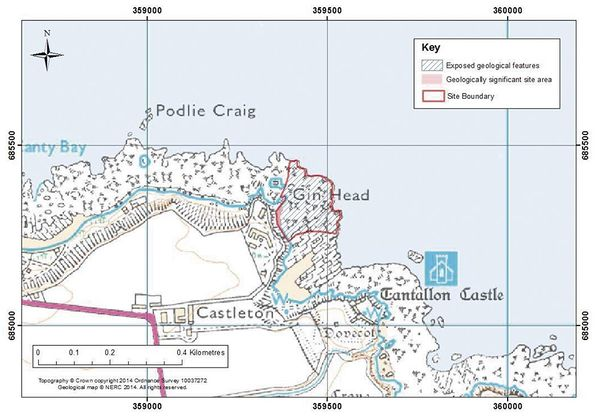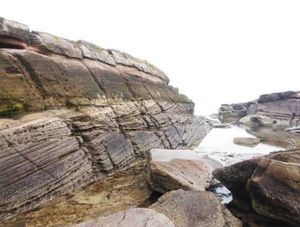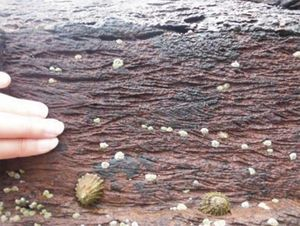Background
Gin Head lies 4 km to the east of North Berwick, along an uneven, rocky, tidal coastline. The lower jawbone of a tetrapod was discovered within sedimentary rocks of the Ballagan Formation here in 1977. The time-span from the end of the Devonian to the early Carboniferous represents an important era in the evolution of tetrapods (i.e. limbed vertebrates). During this 20 million year period, known as ‘Romer’s Gap’, tetrapods evolved from aquatic, fish-like creatures into amphibian-like terrestrial forms. Vertebrate fossils had been previously unknown world-wide from this period. However, an increasing number of vertebrate fossils are being found for the first time from sites in south-eastern Scotland from the Ballagan Formation. This area is thus of international significance in the understanding of this critical adaptation in tetrapod evolution from aquatic to terrestrial environments, and is one of only two such areas in the world at present where this can be studied (the other is in Nova Scotia, Canada). The tetrapod fossils are being investigated by the TW:eed Project (a scientific research collaboration between academic institutes and partners, including the BGS).
Sedimentary Rocks
The sedimentary rocks of the uppermost part of the Ballagan Formation are exposed at this site and consist mostly of a fluvial pink-white, medium-grained sandstone with subordinate mica-rich siltstone beds. These rocks contain a range of sedimentary structures; most notably, striking cross-bedding (ELC_3 P1), erosional channel sand bodies, desiccation cracks within rare mudstones, and ripples within mudstones and siltstones (ELC_3 P2). The strata include a fossiliferous limestone-conglomerate which has yielded tetrapod remains. Whilst this unit was not found in situ at time of site visit, boulders of it were identified near the high tide mark. The fossiliferous rock is composed of clasts of mudstone and sandstone in a carbonate matrix, along with abundant ostracods, bivalves and rarer fossilised wood, gyrocanth spines, lobe-fin fish scales and lungfish toothplates. This rock is interpreted to have been deposited as an accumulation of rock clasts, organic and animal remains at the bottom of a shallow pool set in a fluvial environment.
Structural Geology
Excellent examples of deformation bands cutting the sandstones are found across the site, creating minor (cm-scale) displacements across the sequence (ELC_3 P3). Larger faults are also present, conspicuous by linear absences of rock across the platform. Some of the smaller fault planes are filled with a clast-supported breccia, containing angular fragments of the surrounding sandstone: it is possible these represent cryptic vents where gas streaming along a fracture has deformed the rock relatively in-situ, rather than related to tectonic deformation.
Access and Additional Information
The site is accessed only by a rough traverse along slippery intertidal rocks. The site is cut off by the tide and so knowledge of tide times prior to visit is essential. Access to the west is achieved by walking along the A198 (there are no pavements and care should be taken on the road) toward the private road leading to Canty Bay residential houses. The private road leads downhill until a sharp left hand bend, where the road can be exited to the right, for a footpath heading eastward. The path eventually dies out and access by walking along the shingle is possible until the Gin Head promontory. At this point access is restricted to low tide.
|



